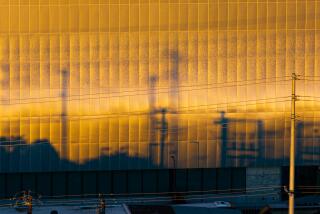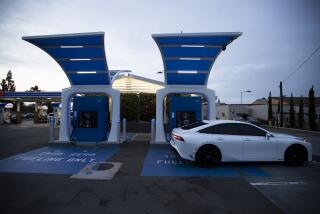Physicist’s Stature Key to Landing Fusion Study : Energy: Marshall Rosenbluth’s lifetime work was instrumental in UC San Diego being picked as site for $1.2-billion research project.
SAN DIEGO — UC San Diego physicist Marshall Rosenbluth spent the last 38 years trying to unravel the mystery of fusion and he doesn’t figure the ultimate solution will be found in his lifetime.
“The more we learn, the more there seems left to do,” says Rosenbluth, whom colleagues affectionately call the “Pope of Plasma Physics.”
Rosenbluth’s stature in the field was among the key reasons that UC San Diego won the opportunity last week to be the headquarters of the International Thermonuclear Experimental Reactor, a prestigious $1.2-billion international fusion research project.
For Rosenbluth and others who have spent their lives in what may well be a century-long quest to harness fusion energy, the ITER project means the long-awaited chance to work out the design for a concept that promises unlimited, inexpensive fuel without pollution.
Fusion generates power by fusing simple atoms, such as hydrogen, mimicking the natural process that occurs at the sun’s core. Fission, the current energy source at the world’s atomic energy plants, splits complex atoms, such as uranium.
For 50 years, supporters have envisioned fusion plants powered by hydrogen atoms culled from sea water. Unlike atomic fission plants that each day produce radioactive waste, fusion plants would be relatively benign.
And, unlike electricity-generating plants that burn fossil fuels, fusion plants would not contribute to global warming or acid rain. Fusion might also make saltwater desalination more cost-effective and produce radioisotopes for medicine and industry.
“The net result is 50 years from now, the world should have an energy source that is available for the next 14 billion years,” said David Overskei, vice president of General Atomics’ fusion energy group.
Proponents acknowledge that under the most optimistic conditions the first commercial plant probably could not be opened until the “end of the first quarter of the next century, said Neal Blue, chairman of La Jolla-based General Atomics.
Indeed, scientists acknowledge they still have not proved that fusion energy can be harnessed and used as an everyday energy source. While many experts believe the technology exists to develop a functioning fusion device, they wonder whether it could ever be refined and simplified so that it could be used by a utility company.
Even if scientists solve the technological problems, fusion could be ignored in favor of cheaper alternatives, like second generation fission or solar power plants.
“Fusion is kind of like a small kid just learning how to walk. I don’t worry about whether or not it will work but how it will do against the competition,” said Thomas Simonen, director of General Atomics’ fusion reactor program in San Diego.
Research into commercial uses for fusion energy began in the early 1950s, as scientists began to grapple with the physics involved in creating a fusion reaction--with temperatures as high as 400 million degrees centigrade--in a laboratory setting.
Fission researchers, beginning a few years earlier, made dramatic advances quickly, in part because their research piggybacked on the extensive military research and development effort that led to the development of atomic bombs.
General Atomics, which has the nation’s second-largest fusion reactor, has assembled one of the largest groups of fusion researchers in the world. Scientists at General Atomics were heavily involved in San Diego’s campaign to acquire the ITER project. The project will be in a building near General Atomics’ $400-million fusion research facility in Sorrento Valley.
The project grew out of the 1985 Geneva Summit between the United States and Soviet Union, which pioneered fusion research. The Soviet Union proposed an international project to finance the huge cost of building an experimental fusion reactor. A year later, officials from the United States, Soviet Union, Japan and the European Community began to plan for how scientists worldwide could collaborate, perhaps through the year 2040, to complete the work.
The ITER project is the second stage of that plan, designing and engineering the planned reactor. It is expected to take six years.
Several countries vied for the honor of this scientific plum, which was divided among San Diego and satellite facilities in Japan and Germany. San Diego won the ITER headquarters largely because of its growing reputation as a center for scientific research, attracting experts such as Rosenbluth.
But ITER officials also were impressed with the economic package that San Diego offered, said Dan Pegg, president of the San Diego Economic Development Corp. The package included $1 million in private and city donations to subsidize housing costs for foreign scientists. And the city’s public and private schools banded together to offer a unique package of educational opportunities designed to ease foreign scientists’ doubts about San Diego schools.
Eighty to 90 scientists will move to San Diego from Japan, Europe and the Soviet Union and from elsewhere in the United States to work on the engineering and design for ITER. The project does not include funds for construction, which would cost an additional $5 billion to $6 billion.
Unlike other energy sources, fusion reactors would be supplied by hydrogen, a virtually inexhaustible fuel. While the fuel supply is relatively simple, there are far more complex problems creating an environment on Earth in which fusion can occur.
At the core of the sun, fusion occurs at a temperature of 14 million degrees centigrade as gravity presses together nuclear particles, kicking off energy.
On Earth, scientists are struggling to contain that type of reaction in fusion reactors, called tokamaks, a Russian acronym for the doughnut-shaped magnet chambers that Soviet scientists invented in the 1960s.
Because hydrogen atoms are positively charged, they automatically push away from each other. The tremendous heat produced in a tokamak allows scientists to press those atoms together in a heated material called plasma. The process requires heat of several hundred million degrees. Scientists at the Princeton Plasma Physics Laboratory’s reactor, the nation’s largest such vessel, were able to achieve a temperature of 400 million degrees centigrade, a world record.
Because standard materials cannot endure that kind of heat, scientists use magnetic fields to keep the plasma away from the tokamak’s container walls. The magnetic field creates an inner “bottle.” But the process is hard to sustain. At General Atomics in San Diego, the tokamak is used for about 10 seconds in each experiment. ITER scientists hope to design a model that could run for as long as two weeks.
The fusion process has been plagued with problems. The plasma initially leaked through the magnetic fields into the vessel walls. Scientists experimented for years before finding the optimum shape for the tokamak--an elliptical D-shape. They also struggled to find effective methods of heating the plasma--finally settling on microwaves and a neutral particle beam, or a beam of rapidly moving hydrogen atoms.
One of the major remaining challenges is to find a material impervious to the tremendous heat. Experts realize that the current stainless steel tokamaks could become radioactive in the fusion process. So the search is concentrating on new types of ceramics, steel, and carbon-based composites.
ITER’s executive director, who has not yet been named, will be in San Diego. This scientist will determine the direction of research at the three centers, beginning in early 1992.
“The actual focus hasn’t been decided,” Rosenbluth said. “Some would like to go ahead with the present materials and try to improve the insulation. Others, like me, think we should concentrate more on the technology issues, developing new materials and studying how to improve the insulating properties of the magnetic field.”
But Rosenbluth is likely to influence the decision.
“Rosenbluth is the grand old man of fusion physics in the U. S.,” said Richard Hora, a vice president with General Dynamics. “It’s an honor to be in the same room with the guy.”
At a press conference with a panel of suit-clad industry officials and UC San Diego Chancellor Richard Atkinson, Rosenbluth showed up in shirt sleeves. With the television cameras running, Rosenbluth explained that he believed the international collaboration was the best avenue for attaining the elusive dream of fusion. Without skipping a beat, Rosenbluth turned to Atkinson, saying: “I am going to hit you now for four or five new faculty positions.”
The U.S. government has spent $6.4 billion on commercial fusion research since it began in 1951. To the frustration of Rosenbluth and others, fusion funding has slowed during the past decade. ITER’s $1.2-billion budget will be spread over a six-year period, but scientists could work faster if funding were immediately available, he said.
The United States accounts for about 20% of the estimated $1 billion that is being spent worldwide each year on fusion research, said Stephen Dean, president of Fusion Power Associates, a Gaithersburg, Md.-based fusion industry association. Fusion research is now funded at about $300 million per year, down from about $500 million during 1984--a cut reflecting across-the-board reductions in energy research.
When asked how much longer before fusion is a reality, Rosenbluth responds more with eagerness than impatience.
“Another 25 to 30 years for a demonstration model which is not completely perfected but close to it,” Rosenbluth said.






